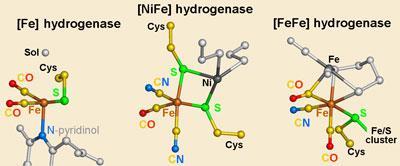All evolutionary roads led to the same way to pull energy out of hydrogen, researchers discover
Scientists in Germany have brought the prospect of generating cheap electricity from hydrogen a step closer by taking a snapshot of an elusive enzyme that can split the gas as efficiently as a platinum catalyst.
In fuel cells currently under development electrons are removed from hydrogen to provide an electric current. At the moment the best way to do this is to use an expensive platinum catalyst. But some micro-organisms can split hydrogen by using enzymes called hydrogenases - raising the possibility that synthetic versions of the enzymes could allow electrical energy to be extracted from hydrogen more cheaply.
Three classes of hydrogenase have been identified. Enzymes from two of these classes have two metals in their active sites - either two iron atoms or an iron and a nickel. Their structures have been imaged using x-ray crystallography. The third class has a single iron atom, but to date no-one has been able to look at their structures in detail.
Now, Seigo Shima of the Max Planck Institute in Marburg and colleagues have successfully crystallised this so-called [Fe]-hydrogenase to reveal the geometry of the active site.

The researchers discovered that, intriguingly, the active site in [Fe]-hydrogenase is remarkably similar to the other two types of enzyme, with the metal atoms attached to carbon monoxide, a sulphur and a nitrogen - in the case of the two-metal centres this nitrogen comes from a cyanide residue. The similarity in structure is unusual because all three types of enzyme evolved independently. ’It seems that nature came three times to the same solution for cleaving hydrogen,’ says team member Ulrich Ermler.
’The work highlights the remarkable convergent evolution that has given us three hydrogenases with a similar active site,’ says David Evans of the John Innes Centre in the UK. ’It is also interesting that all three enzymes have iron atoms bound by toxic groups such as carbon monoxide and cyanide - the only examples in biology where these play a role in an enzyme’s active site.’
In the two-metal system, it is believed that they hydrogen binds first to one of the metals where it is split into a hydride and a proton. Electron transfers involving the second metal then oxidise the hydride to another proton, which is removed.
In the newly characterised active site, once the hydride is produced at the metal centre it is directly transferred to a neighbouring organic redox centre.
’Binding hydrogen gas and splitting it is common to all three,’ says Evans. ’The new structure should help us to understand how the other hydrogenases work, and we might eventually be able to mimic their activity with synthetic compounds.’
Simon Hadlington
References
S Shima et al., Science, 2008, 321, 572 (DOI: 10.1126/science.1158978)






No comments yet